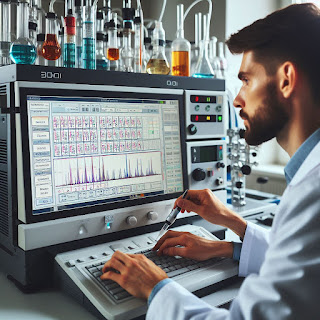Gas Chromatography and it's procedure | Forensic science
Photo By Ai Introduction: |
Gas Chromatography (GC) stands as one of the most widely used analytical techniques across multiple scientific disciplines. It's a powerful tool for separating and analyzing compounds within a complex mixture, providing invaluable insights in fields such as pharmaceuticals, environmental science, food analysis, and forensics. In this blog, we'll explore the principles, procedures, and applications of Gas Chromatography, shedding light on its significance in scientific research.
Understanding Gas Chromatography:
Gas Chromatography operates on the principle of partitioning compounds between a stationary phase and a mobile phase. The sample mixture is injected into a stream of an inert gas (mobile phase), which carries it through a coiled tube or column packed with a stationary phase. As the sample components interact with the stationary phase, they are separated based on their affinity for the stationary phase and the rate at which they travel through the column.
Materials Required:
1. Gas chromatograph
2. Column (packed or capillary)
3. Carrier gas (typically helium or nitrogen)
4. Sample injector
5. Detector (e.g., flame ionization detector, mass spectrometer)
6. Data analysis software
Procedure:
1. Sample Preparation: The sample is prepared by dissolving it in a suitable solvent and filtering to remove any particulate matter.
2. Injection: A small volume of the prepared sample is injected into the gas chromatograph using a syringe or auto-sampler. The injector introduces the sample into the carrier gas stream, which carries it into the column.
3. Separation: Inside the column, the sample components are separated based on their interactions with the stationary phase. Compounds with higher affinity for the stationary phase will spend more time interacting with it, resulting in slower migration through the column compared to those with lower affinity.
4. Detection: As separated compounds exit the column, they pass through a detector where they are identified and quantified based on their physical or chemical properties. Common detectors include flame ionization detectors (FID) and mass spectrometers (MS), each offering unique advantages depending on the application.
5. Data Analysis: The data generated by the detector is processed using specialized software, which provides chromatograms displaying the separation of compounds over time. Peak areas or heights in the chromatogram are proportional to the concentration of the corresponding compounds in the sample.
Applications of Gas Chromatography:
1. Pharmaceutical Analysis: GC is used for analyzing drug formulations, determining drug purity, and identifying impurities.
2. Environmental Monitoring: It helps in detecting pollutants in air, water, and soil samples.
3. Food Analysis: GC is employed in food safety testing for detecting contaminants, pesticides, and additives.
4. Petrochemical Industry: It aids in analyzing hydrocarbon mixtures in crude oil and petroleum products.
5. Forensic Science: GC assists in identifying drugs, explosives, and toxins in forensic investigations.
Significance of Gas Chromatography:
1. High Sensitivity: GC can detect compounds at trace levels, making it suitable for analyzing complex mixtures.
2. Selectivity: The choice of column and detector allows for selective detection and quantification of specific compounds.
3. Speed and Efficiency: GC provides rapid analysis with high resolution, enabling quick turnaround times in laboratories.
4. Quantitative Analysis: GC can accurately quantify the concentration of compounds in a sample, aiding in quality control and regulatory compliance.
5. Versatility: GC can analyze a wide range of compounds, from volatile organic compounds to semi-volatile and non-volatile substances.
In conclusion, Gas Chromatography is a versatile and indispensable analytical technique with broad applications across various scientific disciplines. By understanding its principles and procedures, researchers can unravel the complexities of compound mixtures, paving the way for advancements in fields critical to human health, environmental sustainability, and safety.
